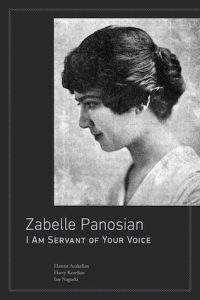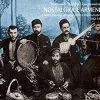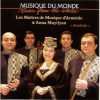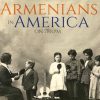
*80 page book with over 50 photos and a 21 track CD.
とんでもない値段になってしまって、ドーしよう、と思いつつ、そっと売り場の片隅に置いておいたのですが、反応があったのはおひとり?それにしても高い、ということで、そのうちセールの時にでも買ってくださいね、なんてお願いしたんですが…、でも、いずれ>こちらで紹介されることを確信していたのでした(って、オイ!)。無断リンク陳謝&感謝します。
基本、その稀有なソプラノの発声は西洋の古典声楽に近いものと聞こえますが、幼い頃から、アルメニア正教会で聖歌をうたっていた人だそうですから、それは納得できるものの、けれど、アルメニアにしてもグルジア(ジョージア)にしても、コーカサスの正教会ゴスペルには不思議な魅力があるのも確かで、例えば、アルメニア王国は世界で初めてキリスト教を公認した国ですから、約千七百年以上の教会の歴史を経て、ゴスペルとはいえ、風土や民俗の影響を受けないわけはないでしょうね、たぶん(とはいえ、蛇足ながら、此処で歌われているのは正教ゴスペルではありませんが…)。
しかも、オスマン・トルコの帝国末期、結果的には100万人というアルメニア人虐殺が行われてしまったわけで、そうした故郷を後にし、北米に移住した女性歌手、ザベル・パノシアンによるアルメニア歌謡録音(1917-18年のSPレコード最初期録音コレクション)ですから、深く望郷の思いも込められているでしょう、そして当然、深い悲しみを湛えた歌ということにもなるでしょう。
まったく、“I AM SERVANT OF YOUR VOICE” …仰せの通り、その歌声には抗しがたいものがあります。
1.Groung (Crane) take 2 3:36
2.Im Sireli Zavagounks (My Beloved Children) take 3 3:45
3.Mir Khor Babge Kerezman (Our Father’s Grandfather’s Grave) take 2 3:09
4.Caroun (Spring) untraced take 3:12
5.Tzain Dour Ov Dzovag (Give Voice O Lake) untraced take 3:18
6.Der Getso (Lord Give Life) take 2 3:20
7.Kilikia (Cilicia) take 1 03:32
8.Khavarel Yem (I Am Darkened) take 1 2:49
9.Togh Tcherke Bibool (Let the Nightingale Not Sing) take 2 2:59
10.Mi Lar Pibool (Don’t Weep, Nightingale) take 1 3:52
11.Charmant Oiseau (from La Perle de Brasil) 4:07
12.Tzain Dour Ov Dzovag (Give Voice O Lake) take 9 4:15
13.Caroun (Spring) take 3 03:41
14.Im Sireli Zavagounks (My Beloved Children) take 5 4:20
15.Groung (Crane) take 7 4:08
16.Tzain Dour Ov Dzovag (Give Voice O Lake) take 1 3:58
17.Caroun (Spring) take 1 3:32
18.Der Getso (Lord Give Life) take 1 3:15
19.Im Sireli Zavagounks (My Beloved Children) take 4 3:28
20.Im Sireli Zavagounks (My Beloved Children) take 6 4:27
21.Groung (Crane) take 1 3:34
22.Groung (Crane) take 5 3:32
〜以下メーカーインフォより
“Zabelle Panosian sang one of the most amazing notes I’ve ever heard – so much humanity, sorrow, promise, infinite longing. When I write my novel the main character will be Zabelle’s note.”
-David Harrington, Kronos Quartet
“Please listen to the Armenian singer, Zabelle Panosian. [Her ‘Groung’] is a secret song that steals away the breath of those who are fortunate enough to hear it.” – Susie Cave
“Like many recorded folk songs, ‘Groung’ is a document of how far it has traveled — from Armenia to the US and back again in ways that it took years for Nagoski, Kezelian, and
Arakelian to put together. It’s a tune that came with Panosian across thousands of miles, grew
and changed with her, and then told its own tale of travel on record, a servant of her voice.”
-Noah Berlatsky, No Depression
“A carefully crafted and detailed, yet succinct biography. Many of us were introduced to Armenian-American singer Zabelle Panosian’s soul-jolting rendition of “Groung” via the 2011 release of To What Strange Place, but here, in Zabelle Panosian: I Am Your Servant, for the first time, we travel with Panosian from her birthplace in Bardizag to her home in New York. We are there in the studio with her at Columbia Records for her historic recordings in lower Manhattan, and we stand with her in the radio studios of WEAF. We become readers of reviews of Panosian’s concerts both celebrated and scathing. We accompany her on performances, minuscule and grand from Waterford to Providence and San Francisco to Fresno, eventually recrossing the Atlantic with her to sing in France, Italy, and Egypt. More than a singer or performer, we learn of Zabelle, the estranged sister, the loving aunt, and the mother who passes the baton to her daughter, Adrina Otero, completing what will be the starting point for future historians or ethnomusicologists wishing to explore Zabelle Panosian and her legacy.”
-Richard Breaux, Associate Professor of Race, Gender, and Sexuality Studies, University of Wisconsin-La Crosse
Among the most significant Armenian singers in the early twentieth century, Zabelle Panosian made a small group of recordings in New York City in 1917-’18. Unaccountably, she was then largely neglected as an artist for more than half a century. This volume by three dedicated researchers is the first effort to reconstruct the life and work of a woman who had an exceptional and cultivated voice — who toured the world as a performer and made a significant contribution to the cultural lives of the Armenian diaspora, the elevation of Armenian art song, and the relief of survivors of the Armenian genocide.
Panosian’s music is derived from a syncretic experience of the Western Armenian village near the sea of Marmara where she was born and a passion for the coloratura sopranos she encountered in Boston. As an immigrant carrying the traumas of dislocation and the loss of her home, she transformed her grief into action, dedicated her life to an expression of the greatest art she could imagine, both from her former life and her new life in America, and she created a path in her wake for her daughter to become a renowned dancer.
Tracing her story from the Ottoman Empire to New England, from the concert halls of Italy, Egypt, and France to California, Florida, and South America through two World Wars, the story of Zabelle Panosian is that of a serious talent recognized and celebrated, dismissed and forgotten, year by year, waiting only to be known and loved again.

 V.A. / NOSTALGIQUE ARMENIE 1942-1952
V.A. / NOSTALGIQUE ARMENIE 1942-1952 AREV ARMENIAN FOLK ENSEMBLE / THE RETURN
AREV ARMENIAN FOLK ENSEMBLE / THE RETURN LES MAÎTRES DE MUSIQUE D’ARMÉNIE & ANNA MAYILYAN / ARAKATZ
LES MAÎTRES DE MUSIQUE D’ARMÉNIE & ANNA MAYILYAN / ARAKATZ V.A. / ARMENIANS IN AMERICA ON 78 RPM, From The Ara Dinkjian Archive
V.A. / ARMENIANS IN AMERICA ON 78 RPM, From The Ara Dinkjian Archive